The 9.7" iPad Pro Review
by Brandon Chester on June 1, 2016 9:00 AM ESTDisplay Analysis
The 9.7" iPad Pro has what is by far the most interesting display I've seen on a tablet since the iPad 3, which was the first of the Retina displays. Samsung is arguably the only other vendor making advances with tablet displays, since they're the only company that ships a calibrated AMOLED. However, Samsung has been limited with the brightness they can push on the larger AMOLED displays, and at the end of the day when you set to sRGB the only advantage is the black level when there's not much ambient light to wash the display out.
With the iPad Pro Apple has improved upon the anti-reflective coating that they introduced with the iPad Air 2, and they've moved to a wider color gamut while also implementing a dynamic color feature called True Tone. I'll be talking about True Tone on the next page, but for now I'll be running 9.7" iPad Pro through our standard display workflow, along with an additional test to examine the accuracy within the DCI-P3 color gamut.
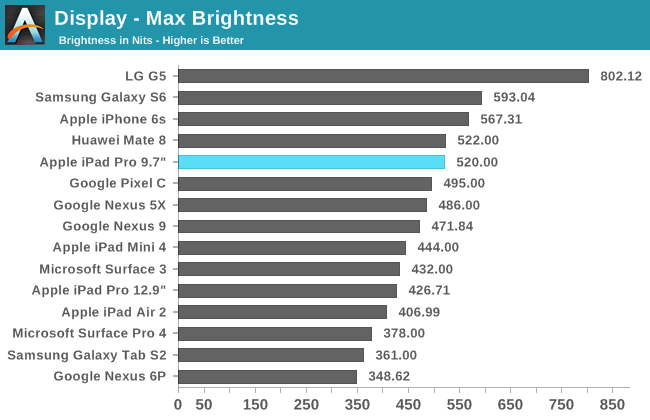
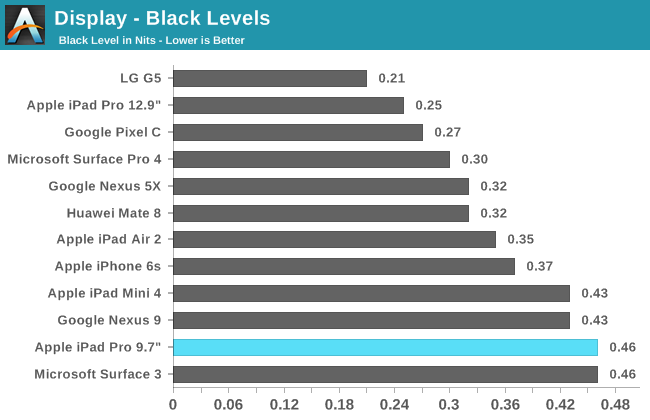
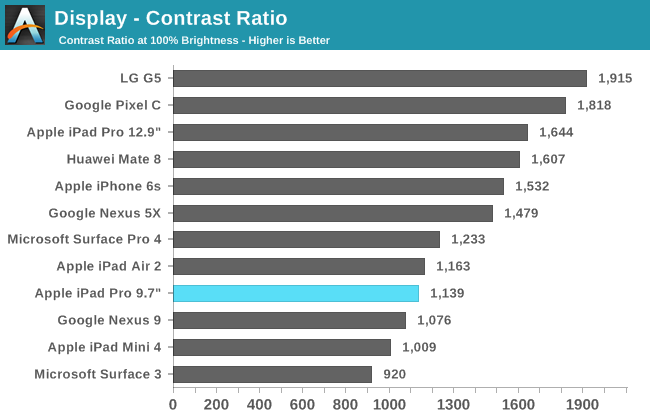
There are two things that I find surprising in the charts above. The first is that Apple actually exceeded their advertised 500 nit brightness. This puts it at the top of our brightness list for tablets, and that's no small feat. Apple's new backlighting array has enabled both a significantly wider gamut and a much higher brightness. Combined with their new anti-reflective coating, the 9.7" iPad Pro handily beats the larger model and the iPad Air 2 as the most usable tablet in bright ambient lighting.
While the 9.7" iPad Pro is quite bright, it doesn't do so well with black levels. Compared to the Pixel C, which has only a slightly lower brightness, the 9.7" iPad Pro's black level is much higher, and the contrast ratio is significantly lower as a result. It's also lower than Apple's 12.9" iPad Pro, and I verified Josh's brightness and black results for the 12.9" iPad against my own to confirm that he didn't just get an exceptional sample. I'm honestly a bit surprised that the gap between the two is so large, as the 9.7" iPad Pro's display is more advanced than the display of the larger model in several respects.
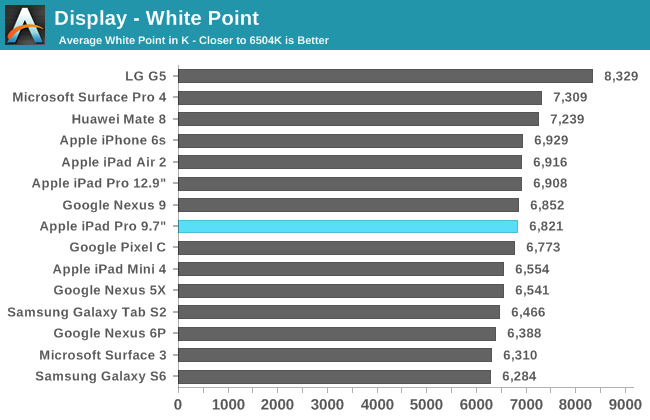
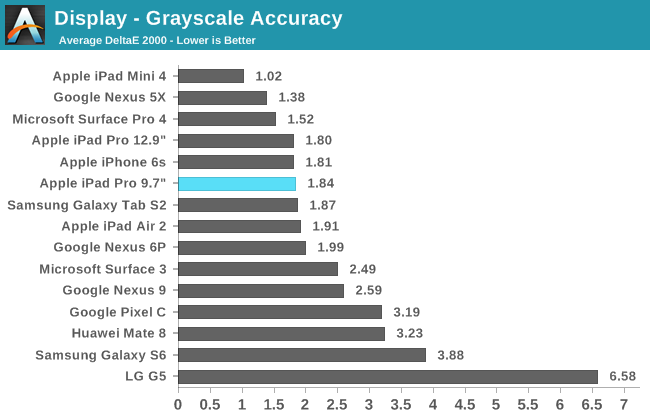
The 9.7" iPad Pro has great greyscale accuracy. Like most of Apple's products, there is a degree of blue shifting, but it's not quite as heavy as on their other products. The gamma is quite straight, and no shade of grey has a DeltaE that hits three, which is generally the goal. The accuracy isn't as high as the iPad Mini 4 which exhibited a surprisingly high degree of accuracy, but beyond the slight blue shift there's not really anything to complain about here.
DCI-P3 Gamut Saturation Sweep
The iPad Pro is Apple's second device that has moved to a wide color gamut. The first was the 2015 iMac with Retina 5K display, and from it we learned a number of things about Apple's implementation. The first thing to make note of is that the display conforms to the DCI-P3 gamut, but it doesn't use the corresponding 2.6 gamma that goes along with the standard. Using that gamma would be a mistake because no content coming on UltraHD Blu-ray is going to use that gamma function, so it's not really an issue in practice. While it remains to be seen how Apple's wide gamut devices will handle content that uses the SMPTE 2084 EOTF, Apple has brought color management to iOS and can transform content that uses a different gamma curve than the 2.2 gamma that the display targets.
Because Apple has implemented color management, they're able to accurately render anything designed for color spaces that sit within the DCI-P3 color space, with the most relevant one being sRGB. For devices with wide color gamuts and color management we'll be testing them against their target gamut and the sRGB gamut for our saturation tests. First up is the DCI-P3 saturation sweep, which uses 20% steps like our sRGB test but obviously targets the wider DCI-P3 gamut and uses Apple's target gamma of 2.2.
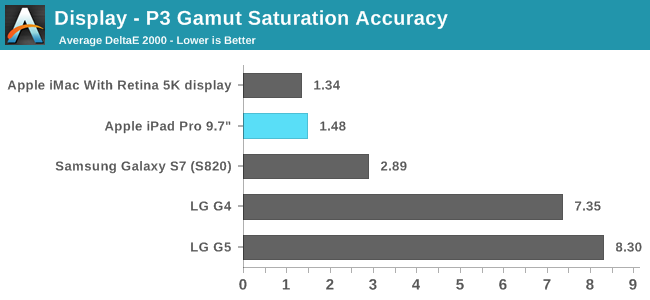
Because only a small group of devices claim to support this color gamut, I don't have as many points of comparison as we usually do. To be honest, the few that we have make it clear that Apple is currently without competition here. The other vendor actively advertising DCI-P3 gamut support is LG, and we've seen that the LG G4 and G5 do not even come close to actually meeting this goal regardless of which gamma target you use. In fact, they're bad enough that Samsung's accurate Adobe RGB mode on the Galaxy S7 accidentally beats them for P3 accuracy here, as it ends up being accurate in areas where the gamuts are very similar and only really has errors along red and with some deep saturations of colors that rely on red or blue.
As for Apple, they're the only vendor that actually covers the red-dependent segment of the gamut and their DeltaE values are incredibly low. The only issue I can see is that green is a bit inaccurate, which seems to be due to the display's blue shift. This is really me looking for criticism though, and with a DeltaE average of 1.48 the only device that beats it is a $2000 iMac.
sRGB Gamut Saturation Sweep
Because each 9.7" iPad Pro is individually calibrated, the color profile included is essentially a perfect description of the physical display's characteristics and color output. Because of this, the profile can be used to map colors from the sRGB color space to the display's native gamut with a high degree of precision, which is only limited by the display's color depth. In fact, this potentially allows for greater accuracy than if the display had been calibrated against the sRGB gamut in the first place, as the small error levels in Apple's calibration are accounted for by the profile and when doing color transformations.
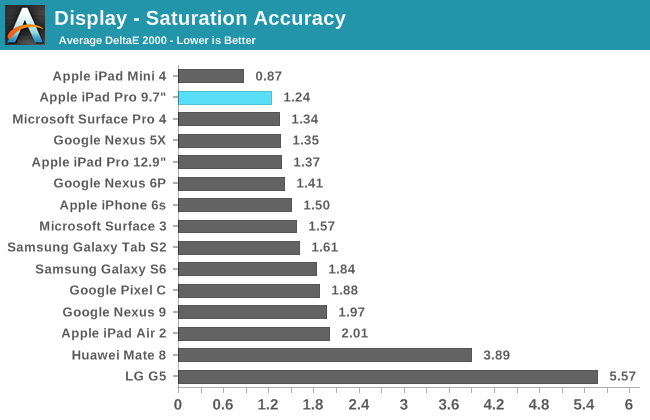
When displaying content designed for the sRGB gamut, the 9.7" iPad Pro is incredibly accurate. It's actually more accurate than the already near-perfect P3 results, with the red, blue, and green primaries being even closer to their target values. The only color that ever has an error above two is 20% saturated yellow, and the largest error is actually white which as we saw earlier is a bit too blue. Aside from those, every color has a DeltaE below two, and many are around or even below one. There's honestly not much more Apple could do here; this really is a professional-grade display.
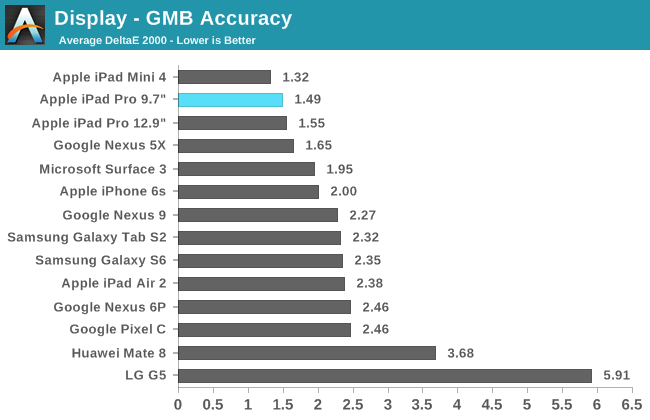
As one would expect, the 9.7" iPad Pro has no trouble rendering the color mixtures from the GretagMacbeth ColorChecker test. The largest errors are actually the greyscale shades, and none of the DeltaE values for colors actually go above two. It's worth noting that the colors in this test are defined such that they should always be the same regardless of the color space, and so the fact that I've targeted sRGB has no change on the test outcome. For reference, changing the target to the P3 gamut produced an average DeltaE of 1.56, and I did that test at a later time so the error is well within the bounds of errors relating to the position of the meter on the display and the small inherent measurement error of the i1Pro 2 itself. This is a good example of Apple's color management at work, as my untagged image files were correctly inferred as having been created with the sRGB color space in mind, and transformed into the display's native gamut.
As far as tablet displays go, the 9.7" iPad Pro has the best one that I've seen. The combination of greatly improved peak brightness, extremely good color accuracy, an improved anti-reflective coating, and support for a wider color gamut all contribute to this, and the usefulness of aspects like the wide gamut will become even more apparent as time goes on and more content supporting it is released.


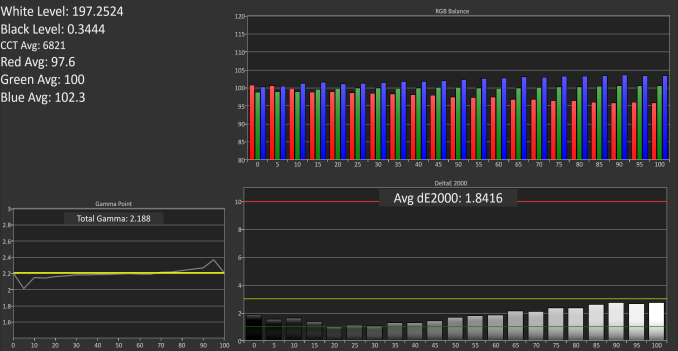
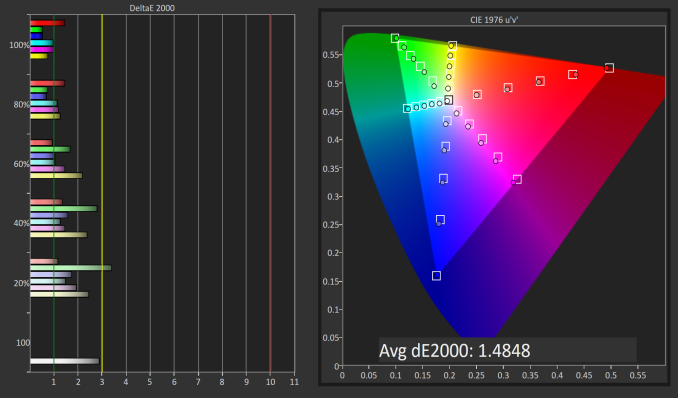
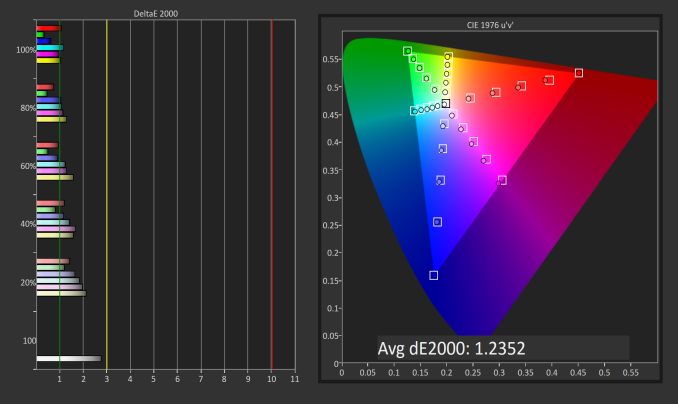
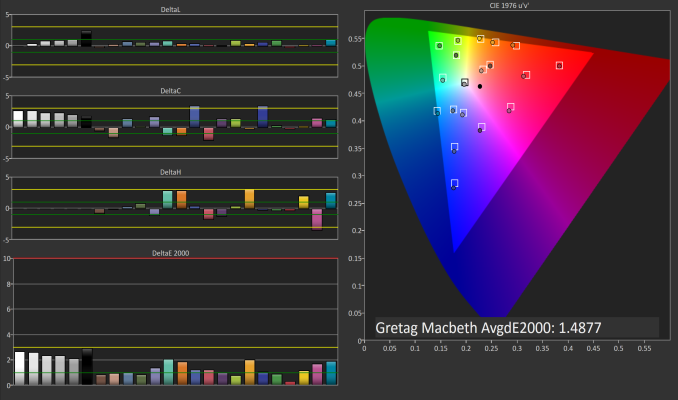








144 Comments
View All Comments
ImSpartacus - Wednesday, June 1, 2016 - link
Whew, finally! Looks like is was worth the wait though. :Pdamianrobertjones - Wednesday, June 1, 2016 - link
I sold my iPad mini 4, just to get one of these, as I'd previously owned the Air 2 and I simply couldn't justify the extra cost. Sure, of course, it is a nice device, but all I did was launch SimCity Builit (Which didn't seem to load faster) and mess around. For all serious tasks I have the Surface Pro 3.It's a lot... for not a lot really. Plus, seeing as the Surface line was initially blasted for not including a stylus/keyboard, it's annoying that Apple sell them for MORE (I think) than the MS versions.
The charts do not include the Surface pro 4 for screen quality. Selective information?
All in all, although nice, it simply wasn't worth the cash (to me).
Brandon Chester - Wednesday, June 1, 2016 - link
The Surface Pro 4 technically doesn't use the same display tests in all cases, such as GMB, as we use a reduced pattern set for mobile. I can add the results that are comparable to the charts. I think as far as size and price go the Surface 3 is the more relevant comparison though, and that was there.dsumanik - Wednesday, June 1, 2016 - link
Gimme a break chester, this is apple's latest and greatest tablet and should be compared head to head with microsoft's latest, on all fronts. That's what apple was shooting for with this product.In fact,
In apples very own keynote they raved about the amount of PC user's that were ditching desktops for an iPad, which is ridiculous because anyone owning a 7 year old PC is not going to be looking to spend 360 bucks just for a keyboard and stylus... LOL!
Brett Howse - Wednesday, June 1, 2016 - link
I'm not sure exactly what your complaint is here. The Surface 3 is a much closer touch point in almost every aspect except for performance. But regardless, we have our online Bench where you can always compare any device and I've even done it for you:http://www.anandtech.com/bench/product/1697?vs=157...
The larger iPad Pro was compared to the Surface Pro 4, as it should be. We keep an online database though so if you want to do any extra comparisons its very simple. Bench is a link at the top of the page.
nikon133 - Thursday, June 2, 2016 - link
It is being marketed as a "Pro" line product... thus it should be compared to other Pro tablets.I haven't read article yet... but I'm presuming tablet runs on platform comparable to larger iPad Pro. I don't think that screen size alone should be the differentiating factor. HP Elitebooks come with screens from 12 to 15.6", for example... can't recall anyone saying that 12" Elitebook is not a business-class laptop just because it is smaller?
dsumanik - Sunday, June 5, 2016 - link
The complaint is that there is inherent apple bias in the that article has extended to the benchmarks.The surface pro 4 may very well be inferior. But this "review" is deceptive. Why not just follow Apple marketing guidelines and compare the ipad pro to "5 year old pc's everyone is leaving for iPad".
Why not just put a single benchmark of a 486 laptop and call it the best?
Vigilant007 - Sunday, August 7, 2016 - link
I can understand not being happy with facets of the review. Chalking up your concerns to "you're a horrible person" isn't the most constructive line of dialogue.It looks like your response was nicely responded to. I'd encourage more discussion instead of tin foil hat guttural response. I think we get it from your responses that your using global stereotypes to paint a picture that everything is inferior to what you have.
All of that said, I haven't been a fan of the Microsoft Surface line till this generation. There's a certain rhythm of finally "getting it" in terms of fit and finish that I don't think Microsoft has had in hardware till this year. The Surface Pro and SurfaceBook are both impressive devices. If what I wanted as an individual could be served by the Windows ecosystem (phone through tablet) I would be giving it a much more serious look.
Apples attitude towards user experience and hardware has been, and still is to a certain degree incredibly different then Microsoft and most other OEMs. You can call it "bad" as much as you want, and that's your right to do so. I have a few iPads in my house, and got one for my little brother to use in college. They are arguably the best overall tablet on the market from hardware onto ecosystem.
Thanks for peeing in the punch bowl because someone doesn't agree with you hence becoming a "horrible person".
KPOM - Wednesday, June 1, 2016 - link
It's $260 for the keyboard and pencil.dsumanik - Sunday, June 5, 2016 - link
not in canada, they gouge us. $360.